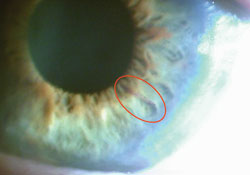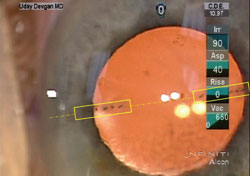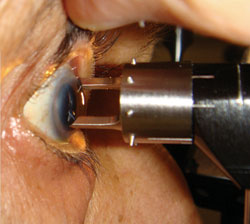Axis marking technique optimizes toric IOL centration
Stromal puncture marks over the center of the pupil are closer to the visual axis than those at the anatomic center of the cornea, maximizing the accuracy of correction.
 Thomas John |
The expansion of cataract surgery into the arena of refractive cataract surgery encompasses new technological innovations such as the toric IOL. Prior to placement of a toric or other premium IOL, the surgeon must ascertain that the astigmatism to be corrected is entirely corneal and not lenticular, and additionally, that the corneal astigmatism is regular, stable and symmetrical. Furthermore, placement of a toric IOL to coincide with the steep axis, proper alignment with the central visual axis and rotational stability of the toric IOL are important factors that influence the surgical outcome and the quality of vision.
Various methods have been described for the proper placement of a toric IOL. In this column, Dr. Devgan describes his surgical technique for proper toric IOL placement to enhance the surgical results of premium IOL surgery.
Thomas John, MD
OSN Surgical Maneuvers Editor
 Uday Devgan |
A novel axis-marking technique enhances the efficiency and accuracy of toric IOL placement, optimizes astigmatism correction and reduces surgical time, according to the surgeon who devised the method.
The Devgan Axis Marker (Accutome), developed by OSN SuperSite Section Editor Uday Devgan, MD, FACS, FRSC(Glasg), enables the surgeon to mark the cornea well in advance of implanting a toric IOL or making a limbal relaxing incision for astigmatism correction.
“Marking within 5° or 10° is easy,” he said, noting that even more accurate marking may be possible. Furthermore, the surgeon can mark the cornea in advance, from several weeks before surgery up to 5 minutes before surgery.
Marking is centered on the patient’s pupil or visual axis; traditional markers do not make that alignment, according to Dr. Devgan.
A slight off-axis deviation can significantly reduce the effectiveness of a corneal marking for toric IOL placement. For example, a lens placed 30° off-axis loses 100% of its optical effectiveness, Dr. Devgan said.
“Looking at a clock, the separation between each minute may seem slight, but it is 6°, and that can mean a 20% loss of optical effectiveness in a toric IOL. If a toric lens that corrects 2 D of corneal astigmatism is off-axis by just 6°, it will lose 0.4 D of its effectiveness,” he said.
Stromal puncture technique
The axis marking device is inserted into the applanation tonometer holder. The device is hollow, allowing clear visualization through its barrel.
Dr. Devgan first dials the exact axis he chooses. Then, when marking the eye, he positions the microscope beam coaxially, shooting down the barrel of the device. Looking down the device, he centers on the pupil. When the patient looks down this tube and fixates on the slit lamp light, Dr. Devgan is able to center on the patient’s visual axis.
 Ink markings show the steep axis and pupil centration in preparation for implantation of a toric IOL. The markings are guides for the creation of more permanent stromal puncture marks to enhance accurate IOL centration. |
 Cystotome is used to make anterior stromal puncture marks in the cornea to ensure accurate toric IOL placement. The stromal marks last longer than traditional ink markings, enabling the surgeon to make the marks several weeks before surgery. Images: Devgan U |
 During implantation, toric IOL markings are aligned with the axis of astigmatism and the visual axis to maximize accuracy. |
 The Devgan Axis Marker has a hollow core that affords unobstructed visualization and accurate centration of corneal markings with the pupil and visual axis. |
With the device centered over a nondilated pupil, Dr. Devgan makes small ink marks on the cornea and then uses a 27-gauge or 25-gauge cystotome to make anterior stromal puncture marks. The puncture marks are longer-lasting than traditional ink markings.
Puncture marks are not perfect, however, because a patient sitting at the slit lamp can still tilt his or her head a couple of degrees one way or another, he said, or the dialed-in axis may not be exact.
“It is better but not perfect,” he said.
Astigmatic changes in cornea
When implanting a toric IOL, a surgeon must account for astigmatism change resulting from the clear corneal incision, Dr. Devgan said. Achieving small, consistent phaco incisions with reproducible flattening is essential to achieving accuracy with toric IOL calculations.
This axis marking technique is also effective for limbal relaxing incisions as well as centration of multifocal IOLs.
The ultimate goal is to have intraoperative microscope overlays showing corneal topography as well as real-time aberrometry to ensure full correction of refractive errors, he said. – by Matt Hasson
References:
- Gualdi L, Cappello V, Giordano C. The use of NIDEK OPD Scan II wavefront aberrometry in toric intraocular lens implantation. J Refract Surg. 2009;25(1 Suppl):S110-S115.
- Koshy JJ, Nishi Y, Hirnschall N, et al. Rotational stability of a single-piece toric acrylic intraocular lens. J Cataract Refract Surg. 2010;36(10):1665-1670.
- Kwartz J, Edwards K. Evaluation of the long-term rotational stability of single-piece, acrylic intraocular lenses. Br J Ophthalmol. 2010;94(8):1003-1006.
- Uday Devgan, MD, FACS, FRCS(Glasg), is in private practice at Devgan Eye in Los Angeles, chief of ophthalmology at Olive View UCLA Medical Center and an associate clinical professor at the UCLA School of Medicine. He can be reached at 11600 Wilshire Blvd., Suite 200, Los Angeles, CA 90025; 800-337-1969; fax: 310-388-3028; e-mail: devgan@gmail.com. Dr. Devgan is a speaker for Accutome and will receive royalties from the sale of the Devgan Axis Marker.
- Thomas John, MD, OSN Cornea/External Disease Board Member, is a clinical associate professor at Loyola University Chicago and is in private practice in Tinley Park and Oak Lawn, Ill. He can be reached at 708-429-2223; fax: 708-429-2226; e-mail: tjcornea@gmail.com.

